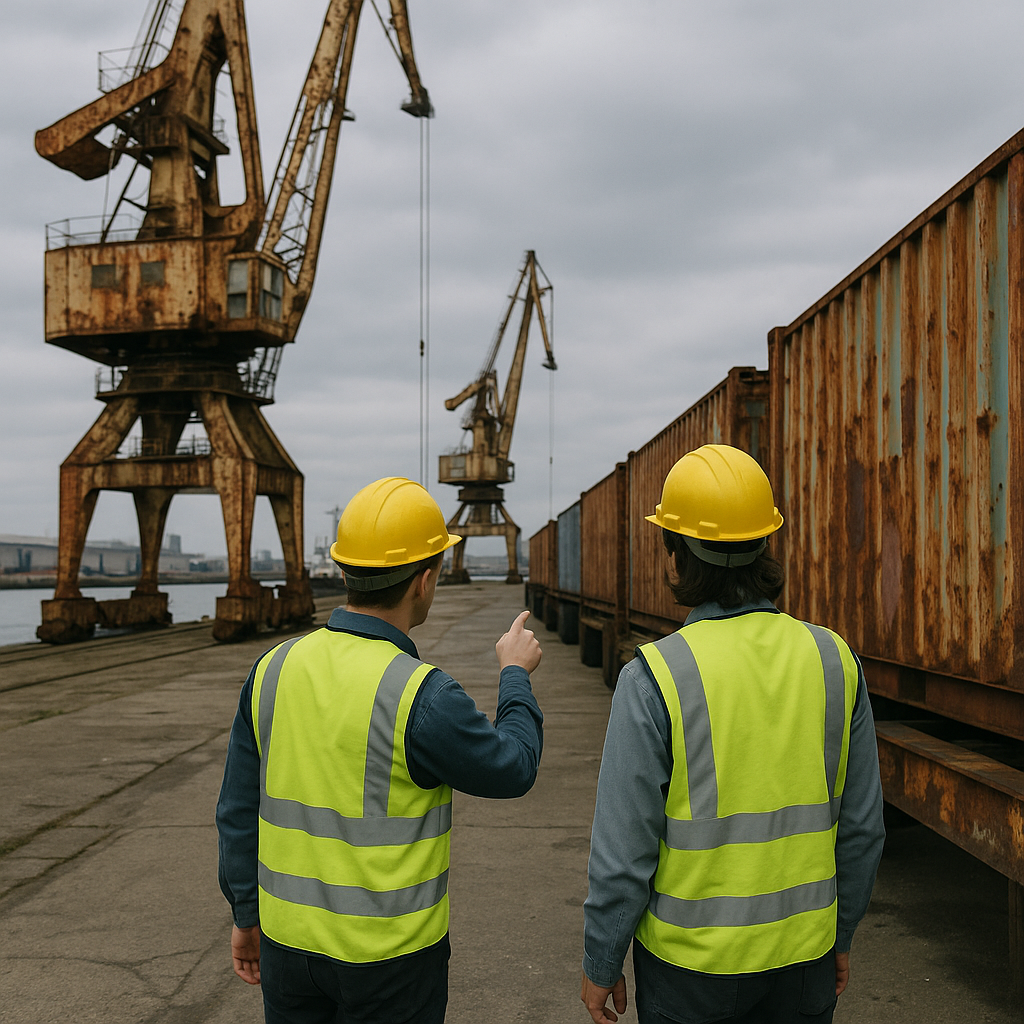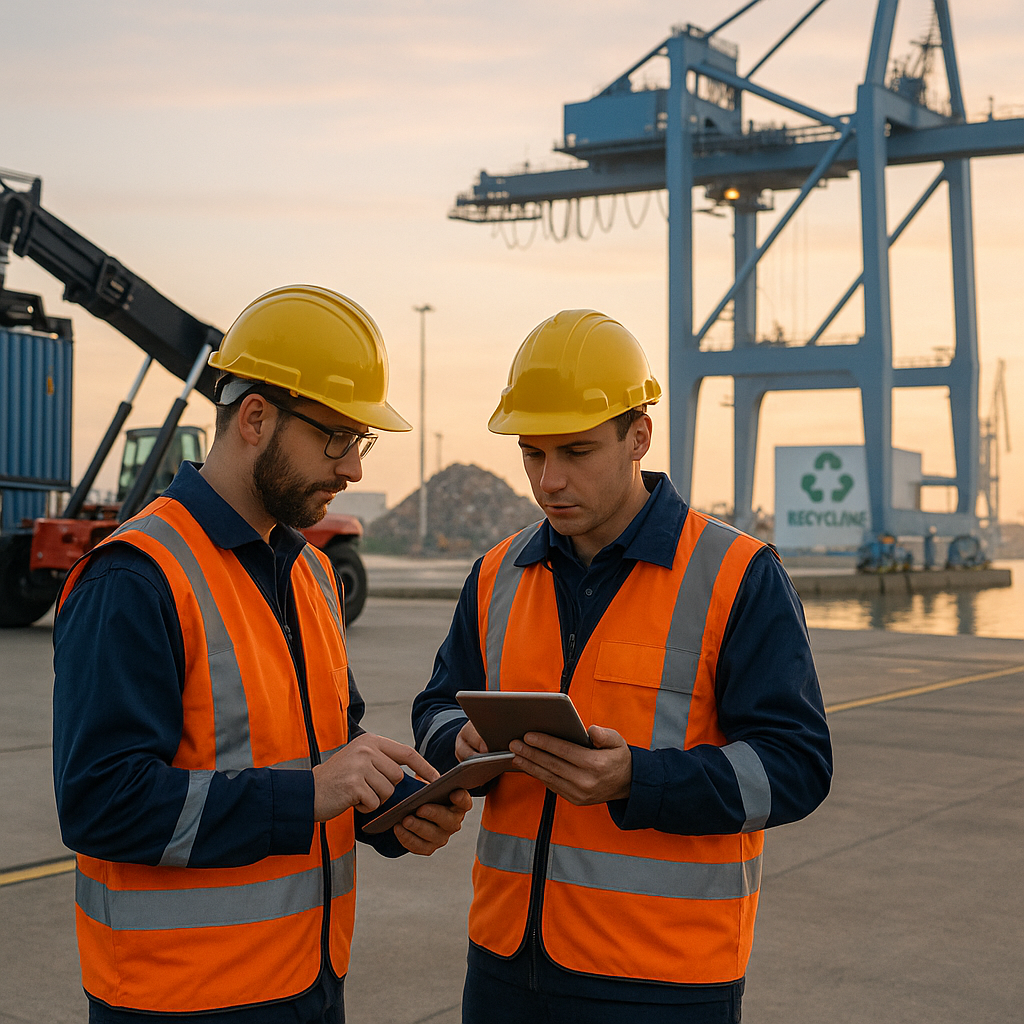5901 Botham Jean Blvd, Dallas, TX 75215
Recycling Port and Harbor Equipment: Challenges and Solutions
August 1, 2025Each year, over 1.2 million tons of obsolete port equipment reach end-of-life globally. This increasing amount of maritime waste includes everything from massive cranes to specialized handling equipment. The volume grows by about 8% annually as ports modernize their operations.
Ports and harbors worldwide face rising pressure to properly dispose of aging infrastructure. The unique composition of maritime equipment presents complex recycling challenges. Most port equipment contains a mix of metals, hydraulic fluids, electronics, and specialized materials designed to withstand harsh saltwater environments.
The environmental stakes are high. Improper disposal of port equipment can release contaminants directly into sensitive marine ecosystems. Many harbors already struggle with legacy pollution issues from decades of industrial activity. As regulatory standards tighten worldwide, port authorities must develop sustainable solutions for managing this specialized waste stream.
What Are the Key Obstacles in Recycling Port and Harbor Equipment?

Recycling port and harbor equipment presents unique challenges that go beyond typical recycling operations. With an increasing focus on sustainability in maritime operations, understanding these obstacles is crucial for ports aiming to improve their environmental practices. Here are the major hurdles that ports worldwide face when attempting to recycle their equipment and materials.
Limited Disposal Areas
One major challenge in port recycling efforts is the scarcity of suitable disposal areas, particularly for materials like dredged sediment, which are produced in large quantities during routine port maintenance.
For instance, the Port of Rotterdam, one of Europe’s busiest ports, struggles to find adequate space for disposing contaminated dredged materials. The port generates millions of cubic meters of sediment annually, much of which cannot be dumped at sea due to contamination levels. Finding land-based disposal sites within a reasonable distance has become increasingly difficult as urban development encroaches on potential disposal areas.
Similarly, ports along the U.S. East Coast face severe limitations in disposal capacity for dredged material. The Port of New York and New Jersey has developed innovative solutions, including artificial reefs and rehabilitating brownfield sites, to manage their dredged material, as traditional disposal options have reached capacity.
Complex Permitting Processes
The regulatory landscape surrounding port equipment recycling involves multiple agencies and layers of oversight, creating a complex web of permitting requirements that can significantly delay or even halt recycling initiatives.
In the United States, obtaining permits for recycling activities in ports typically requires approvals from the Environmental Protection Agency (EPA), Army Corps of Engineers, state environmental agencies, and local authorities. Each entity has different requirements and timelines, creating a bureaucratic maze for ports.
The Port of Baltimore provides a striking example of such permitting complexities. When implementing a program to recycle end-of-life cranes and handling equipment, port authorities faced a two-year permitting process, involving environmental impact assessments, public hearings, and multiple revisions to their recycling plans before approval was granted.
Cost-Sharing Challenges Among Stakeholders
The financial burden of recycling port equipment is substantial, and determining who is responsible for these costs creates significant friction among stakeholders. Port authorities, terminal operators, shipping lines, and local governments often disagree about financial responsibility for recycling initiatives.
At Singapore’s port, one of the world’s busiest container terminals, a major obstacle to implementing comprehensive recycling programs has been the distribution of costs. Terminal operators resist bearing the full expense of recycling large equipment like gantry cranes and straddle carriers, arguing that these costs should be shared with port authorities or incorporated into user fees. These disagreements have stalled progress on several large-scale recycling projects.
The situation is further complicated when equipment ownership is distributed among multiple entities, common in many European ports where public-private partnerships are prevalent. Determining financial responsibility becomes even more challenging when equipment has been used by multiple operators over its lifetime.
Environmental Regulation Constraints
Stringent environmental regulations, while necessary for protecting ecosystems, create additional obstacles for port recycling efforts. These regulations often restrict when and how recycling activities can occur.
The Port of Savannah in Georgia faces strict “environmental work windows” that limit when certain activities can take place to protect endangered species and critical habitats. These time restrictions mean that recycling operations for large equipment must be scheduled during specific periods, often creating operational bottlenecks and increasing costs.
Similarly, ports in California must comply with some of the world’s strictest air quality regulations, which limit the types of equipment and processes that can be used for dismantling and recycling large port equipment. These restrictions, while environmentally beneficial, add significant complexity and cost to recycling operations.
Logistical Challenges of Size and Composition
Port equipment is notoriously difficult to recycle due to its massive size and complex composition of materials. Container cranes can stand over 100 meters tall and weigh hundreds of tons, making dismantling and transportation extremely challenging.
The Port of Hamburg faced significant logistical hurdles when attempting to recycle several outdated container cranes. The sheer size of the equipment required specialized cutting equipment and heavy-lift vessels, and the mixed composition of materials (including steel, copper wiring, hydraulic fluids, and electronic components) necessitated careful segregation during the recycling process.
Additionally, many pieces of port equipment contain hazardous materials such as asbestos, PCBs, and heavy metals, particularly in older equipment. The Port of Long Beach discovered this challenge when recycling equipment from their older terminals, finding that specialized handling and disposal requirements for these hazardous components significantly increased the complexity and cost of their recycling efforts.
Port vehicles like straddle carriers and reach stackers contain a mix of materials including metals, plastics, electronics, and various fluids, making them difficult to process through standard recycling channels. Each component requires different recycling approaches, further complicating the process.
| Obstacle | Description | Impact |
| Limited Disposal Areas | Scarcity of suitable disposal sites for materials such as dredged sediment. | Increases difficulty in managing waste, leading to innovative solutions like artificial reefs. |
| Complex Permitting Processes | Involves multiple agencies and layers of oversight for recycling activities. | Significantly delays or halts recycling initiatives due to bureaucratic hurdles. |
| Cost-Sharing Challenges Among Stakeholders | Disagreements on who bears financial responsibilities for recycling costs. | Stalls progress on large-scale recycling projects due to financial disagreements. |
| Environmental Regulation Constraints | Stringent regulations restrict when and how recycling can occur. | Creates operational bottlenecks and increases costs due to time and process restrictions. |
| Logistical Challenges of Size and Composition | Massive size and complex material composition of port equipment. | Requires specialized handling and increases recycling complexity and costs. |
| Technological and Expertise Gaps | Lack of specialized knowledge and technology for recycling maritime equipment. | Requires additional investment or long-distance transport to specialized facilities. |
Technological and Expertise Gaps
Many ports lack the specialized knowledge and technologies required for efficiently recycling large-scale maritime equipment. Traditional recycling facilities are rarely equipped to handle the unique challenges posed by port equipment.
The Port of Seattle encountered this obstacle when attempting to recycle decommissioned container handling equipment. The port found that local recycling facilities lacked both the specialized equipment needed to process large steel structures and the expertise to safely handle the complex hydraulic and electrical systems contained within the machinery.
This technological gap forces ports to either invest in developing in-house capabilities or transport equipment long distances to specialized facilities, both options adding significant costs to recycling efforts.
How Does Environmental Contamination Impact Recycling Efforts?

Port sites worldwide face significant environmental contamination challenges from decades of industrial activities. Legacy pollutants, including petroleum products, heavy metals, and chemical residues, often permeate soil and equipment. This contamination creates substantial obstacles for recycling and redevelopment initiatives.
Water pollution ranks as the top environmental concern for port authorities globally, according to research published in the journal Sustainability. This contamination directly impacts the feasibility and cost-effectiveness of recycling operations. When materials are tainted with hazardous substances, they require specialized handling that can make recycling economically unviable.
Common Contamination Challenges at Port Sites
Port sites typically contain several types of contamination that complicate recycling efforts:
- Soil contamination: Heavy metals, oil spills, and industrial chemicals often seep into port soils over decades of operation. Studies have found elevated levels of pollutants, such as heavy metals, near port areas.
- Equipment contamination: Machinery and infrastructure may contain hazardous materials like PCBs, asbestos, and lead-based paint, requiring careful remediation before recycling.
- Water-based pollution: Sediments in port waters frequently contain concentrated pollutants that can affect nearby recycling operations and limit the reuse potential of dredged materials.
When recycling materials from contaminated port sites, standard processing methods often prove insufficient. Materials tainted with hazardous substances cannot enter conventional recycling streams without posing risks to human health and the environment.
Specialized Treatment Requirements
Addressing contaminated materials requires specialized approaches that add complexity and cost to recycling efforts:
- Material testing and categorization: Each component must undergo assessment to determine contamination levels before appropriate recycling pathways can be identified.
- Decontamination processes: Specialized cleaning techniques, including thermal treatment, chemical washing, or bioremediation, may be necessary before materials can be recycled.
- Segregation protocols: Contaminated materials must be carefully separated from unaffected materials to prevent cross-contamination.
These specialized requirements often make recycling contaminated materials significantly more expensive than sourcing virgin materials, creating economic barriers to sustainable practices.
Brownfield Redevelopment: Challenges and Opportunities
Port brownfields – abandoned or underused industrial sites with environmental contamination – present both significant challenges and unique opportunities for recycling innovation. These sites contain valuable materials and infrastructure that could be reclaimed through proper remediation.
The challenges of brownfield recycling include:
- Regulatory hurdles and liability concerns that may deter investment
- Technical complexity of safely handling mixed contaminants
- High upfront costs for testing and specialized treatment
Despite these obstacles, brownfield sites offer compelling opportunities for circular economy approaches. Rather than viewing contamination as merely a problem, innovative ports are treating it as a resource management challenge with potential solutions that benefit both the environment and local economies.
Case Study: Port of Rotterdam’s Circular Economy Initiative
The Port of Rotterdam provides an excellent example of successful contaminated site recycling. Faced with significant soil contamination from decades of industrial activity, port authorities implemented a comprehensive recycling strategy rather than relying on traditional disposal methods.
Their approach included:
- Establishing a soil bank to properly categorize and store contaminated soils
- Implementing thermal treatment technology to clean petroleum-contaminated soils
- Creating a closed-loop system where treated materials are reused in port construction projects
This initiative transformed a waste disposal problem into a resource opportunity. Contaminated soils that would have required expensive offsite disposal were instead treated and repurposed within the port. The program reduced disposal costs while creating usable materials for ongoing development projects.
Innovative Approaches to Contamination Challenges
Forward-thinking ports are exploring several innovative strategies to address contamination barriers to recycling:
- On-site treatment facilities: Dedicated processing equipment at port locations can make contaminated material recycling more economically viable by reducing transportation costs.
- Phytoremediation: Using specific plants to extract or break down contaminants provides a low-cost, sustainable approach to cleaning soils before recycling.
- Material banks: Creating centralized systems to inventory, track, and match contaminated materials with appropriate treatment and reuse opportunities.
These approaches recognize that environmental contamination, while challenging, doesn’t necessarily prevent recycling. With proper techniques and systems, many contaminated materials can be safely returned to productive use rather than requiring disposal.
Future Directions for Contaminated Site Recycling
The future of recycling at contaminated port sites will likely involve more sophisticated integration of remediation and recycling processes. Emerging technologies are making it increasingly possible to address contamination while preserving material value.
Key developments include:
- Advanced material separation technologies that can effectively sort contaminated from uncontaminated components
- Chemical processes that selectively target and neutralize contaminants without destroying material integrity
- Digital tracking systems that enable more precise management of materials throughout the remediation and recycling process
These advances point toward a future where environmental contamination, while still a significant challenge, becomes less of a barrier to effective recycling at port sites.
Environmental contamination at port sites presents substantial challenges to recycling efforts. The presence of hazardous materials requires specialized handling, treatment, and disposal methods that add complexity and cost. However, through innovative approaches and dedicated resources, many ports are finding ways to overcome these obstacles, transforming contamination challenges into opportunities for more sustainable material management.
Conclusion: Shaping the Future of Port Equipment Recycling

Recycling port and harbor equipment is at a pivotal juncture. Effective port equipment recycling requires a comprehensive approach that balances environmental responsibility with economic viability. The way forward involves innovative disposal methods, streamlined regulatory processes, and advanced recycling technologies that optimize resource recovery while reducing energy consumption.
Progress in this field relies on meaningful collaboration among stakeholders. When port authorities, equipment manufacturers, recycling specialists, and regulatory bodies coordinate their efforts, circular economy principles can transition from aspirational concepts to achievable outcomes. Transforming outdated cranes, forklifts, and maritime vessels into valuable resources is not only an environmental necessity but also a strategic advantage for forward-thinking ports in a sustainability-conscious global market.
For ports dealing with equipment recycling challenges, contact Okon Recycling at 214-717-4083. Their specialized expertise in industrial recycling can assist your port operation in developing sustainable equipment disposal solutions that comply with regulations while supporting your environmental stewardship goals.
